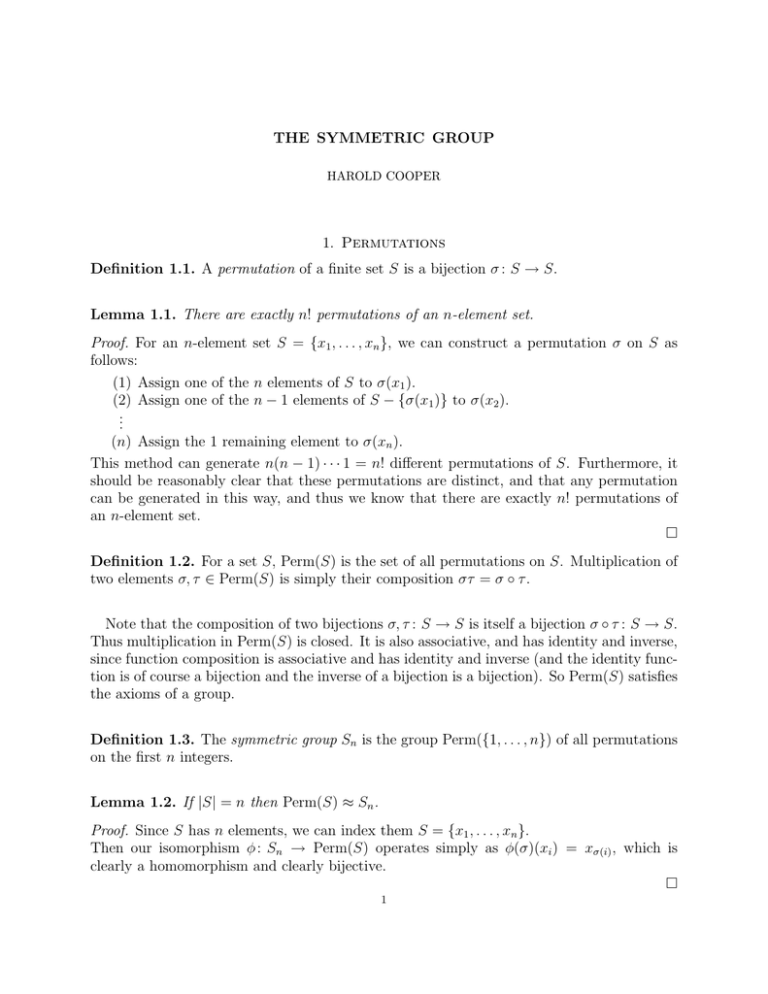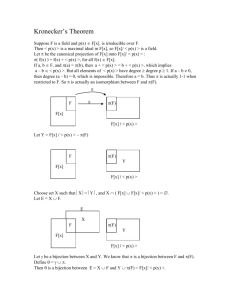THE SYMMETRIC GROUP 1. Permutations
advertisement

THE SYMMETRIC GROUP
HAROLD COOPER
1. Permutations
Definition 1.1. A permutation of a finite set S is a bijection σ : S → S.
Lemma 1.1. There are exactly n! permutations of an n-element set.
Proof. For an n-element set S = {x1 , . . . , xn }, we can construct a permutation σ on S as
follows:
(1) Assign one of the n elements of S to σ(x1 ).
(2) Assign one of the n − 1 elements of S − {σ(x1 )} to σ(x2 ).
..
.
(n) Assign the 1 remaining element to σ(xn ).
This method can generate n(n − 1) · · · 1 = n! different permutations of S. Furthermore, it
should be reasonably clear that these permutations are distinct, and that any permutation
can be generated in this way, and thus we know that there are exactly n! permutations of
an n-element set.
Definition 1.2. For a set S, Perm(S) is the set of all permutations on S. Multiplication of
two elements σ, τ ∈ Perm(S) is simply their composition στ = σ ◦ τ .
Note that the composition of two bijections σ, τ : S → S is itself a bijection σ ◦ τ : S → S.
Thus multiplication in Perm(S) is closed. It is also associative, and has identity and inverse,
since function composition is associative and has identity and inverse (and the identity function is of course a bijection and the inverse of a bijection is a bijection). So Perm(S) satisfies
the axioms of a group.
Definition 1.3. The symmetric group Sn is the group Perm({1, . . . , n}) of all permutations
on the first n integers.
Lemma 1.2. If |S| = n then Perm(S) ≈ Sn .
Proof. Since S has n elements, we can index them S = {x1 , . . . , xn }.
Then our isomorphism φ : Sn → Perm(S) operates simply as φ(σ)(xi ) = xσ(i) , which is
clearly a homomorphism and clearly bijective.
1
2. Group Operations
Definition 2.1. Given a group G and a set S, a group operation by G on S is a product
mapping (written like multiplication) from G × S to S, with the property that the identity
of G fixes every element in S, and for all g, g 0 ∈ G and s ∈ S, g(g 0 s) = (gg 0 )s.
Lemma 2.1. Given an operation by G on S, every g ∈ G permutes S.
Proof. Let us denote the function corresponding to a given element g ∈ G under a certain
operation on S as g∗ : S → S defined by g∗ (s) = gs for all s ∈ S.
G is a group, so g has an inverse g −1 , which itself has a corresponding function g∗−1 : S → S
under the given operation. We have for any s ∈ S that g∗−1 (g∗ (s)) = g −1 (gs) = (g −1 g)s = s
and g∗ (g∗−1 (s)) = g(g −1 s) = (gg −1 )s = s.
So g∗ is a function with an inverse, so it must be bijective, and since it maps S to S it is
thus by definition a permutation.
Thus the function corresponding to every group element under any group operation on a set
S is a permutation of S, i.e. for all g ∈ G, g∗ ∈ Perm(S).
Thus given a group operation we can define a homomorphism φ : G → Perm(S) simply
by φ(g) = g∗ (with g∗ defined as above). (It is left as a [dull] exercise to show that this is
indeed a homomorphism.)
3
Theorem 3.1 (Cayley’s Theorem). Every group of order n is isomorphic to a subgroup of
Sn .
Proof. Suppose G a group of order n.
Let G operate on itself by left multiplication. Then by our lemma on group operations we
have a homomorphism φ : G → Perm(G). If gg 0 = g 0 then g = 1, so the only element acting
as the trivial permutation is the identity, i.e. φ(g) = 1 ⇐⇒ g = 1 so φ is injective.
But then by the First Isomorphism Theorem, im φ ≈ G/ ker φ = G/{1} ≈ G.
So G ≈ im φ ⊂ Perm(G) is a subgroup of Perm(G), but of course Perm(G) ≈ Sn , so G is
isomorphic to a subgroup of Sn .
2
Theorem 3.2. GL2 (F2 ) ≈ S3
Proof. Let G = GL2 (F2 ).
a b
For A =
∈ G, det A = ad − bc 6= 0 ⇒ ad 6= bc which can happen in 6 ways,
c d
so |GL2 (F2 )| = 6. And we know from above that |S3 | = 3! = 6.
1
0
1
Let S =
,
,
be operated on by G simply by left matrix multiplication.
0
1
1
As shown above this gives a homomorphism φ : G → Perm(S).
a b
1
a
0
b
1
For A =
∈ S, A ·
=
, while A ·
=
. Thus both
and
c d
0
c
1
d
0
0
are only fixed by the identity. In other words, every nontrivial element of G acts on S
1
in a nontrivial way, i.e. φ(g) = 1 ⇐⇒ g = 1, or φ is injective.
And we can compose this homomorphism with the isomorphism between Perm(S) and S3
(since |S| = 3) to get an injective homomorphism ψ : G → S3 , which since |G| = |S3 | = 3
must be an isomorphism.
3



![advanced cp theory]](http://s2.studylib.net/store/data/005381128_1-1c81f7fcca4a0bd051a0840b6002170d-300x300.png)